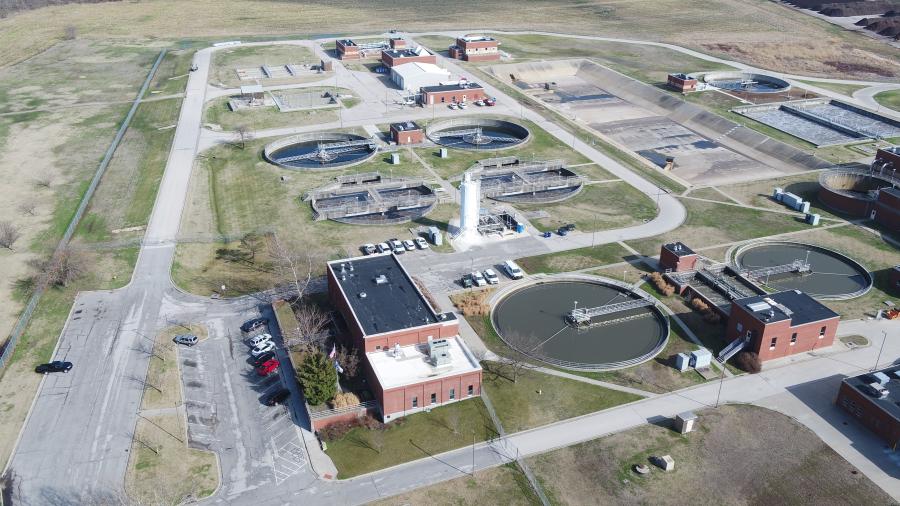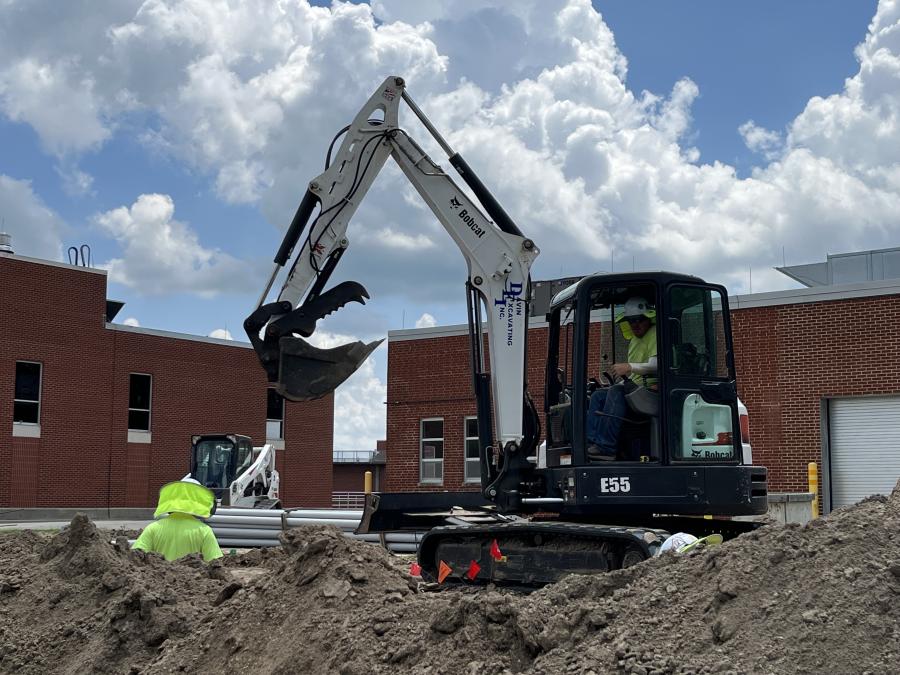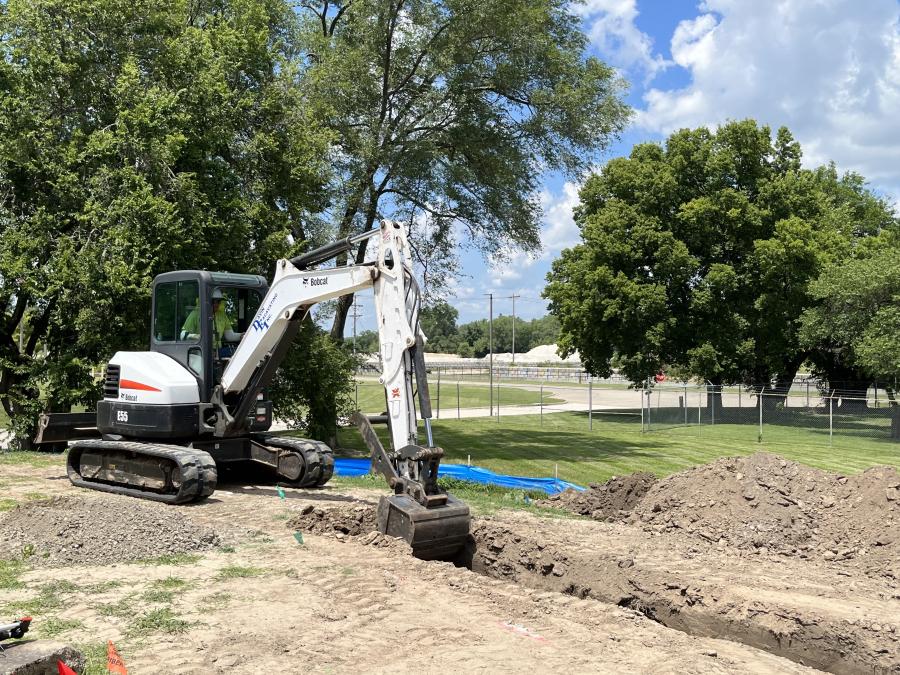The Kansas River plant, which receives approximately three-quarters of the city’s wastewater, was originally opened in the mid-1950s.
(City of Lawrence photo)
As the area's second-largest funded wastewater project, a $74 million undertaking by the city of Lawrence, Kan., will better serve the community when it's completed by the end of 2026. The mission is to meet discharge standards while improving reliability.
"This is regulatory compliance that the city has to abide by in order to operate and maintain a wastewater treatment plant," said Leah Morris, city of Lawrence engineering program manager. "It's important to strive for the highest standards to keep our community and our environment safe."
The Kansas River Wastewater Treatment Plant improvements are required to meet the National Pollutant Discharge Elimination System (NPDES) regulatory permit requirements issued by the Kansas Department of Health and Environment.
"This project meets the strategic plan in the area of Connected City with progress indicators including effective and efficient processes, sound fiscal stewardship and environmental sustainability," said Morris, who noted the changes are a significant expense.
"The cost of regulatory compliance gets higher every year, but the city strives to make decisions that will help lower the cost of operations with each large improvement."
The city of Lawrence operates and maintains two wastewater treatment plants that reduce or eliminate trash, ammonia and harmful pathogens from entering the environment. The Kansas River plant, which receives approximately three-quarters of the city's wastewater, was originally opened in the mid-1950s, and has an average daily flow of 8 million gal. per day (MGD). As an end-of-line facility that processes and discharges treated wastewater into the Kansas River, the plant must remain functional throughout the construction process.
Crews are preparing the electrical infrastructure for the upgrades in order to have everything ready for the new equipment.
"The city anticipates no disruption to the daily resident," said Morris. "However, behind the scenes, the wastewater division will be working nonstop to ensure compliance is met during construction, diverting flow in order to provide access to specific process basins and equipment, and learning about the new treatment process as it's being built in order to gain knowledge on the new process at that plant."
The biggest challenge, besides budget, will be maintaining operations during construction.
"The city doesn't have an alternate plant for all the wastewater. Only a portion of the wastewater flow can be sent to the Wakarusa Plant on the other side of Lawrence. Every basin, pipe and piece of equipment that needs work during construction must stop being a part of the wastewater process.
"This requires redundancy as well as thorough planning focusing on critical elements of safety and downtime. Some parts of the process can only be down for a limited time before the wastewater treatment process is compromised, therefore affecting the quality of the effluent water that is sent back into the river."
According to Morris, the work includes replacing major motor control centers and upgrading electrical equipment.
"Consider it to be similar to replacing the electrical transformer to your home, as well as any controls to your appliances or HVAC system. That involves dealing with power outages, followed by making sure that every single outlet works and is putting out the required energy that it needs to. Then there's the reprogramming of your appliances to function correctly."
Crews also must deal with the conversion from aeration to a biological nutrient removal treatment process.
"From a construction standpoint, it requires a longer startup period, because you need to make sure that the BNR process is working before moving on to the next major task," said Morris, who added that converting a chlorine contact basin into a new UV facility requires building a new facility on top of an old one, as well as making sure the current structure can support the new one.
Workers also will construct a new SCADA facility with a new fiber loop.
"The new building is where our department server will be housed, and our SCADA staff will operate out of, to support all the water, wastewater and stormwater equipment and facilities. The fiber loop will only be partly new, as we have a looped system currently."
Morris said crews will be always keeping a close eye on the weather.
"When it rains, due to inflow and infiltration [I&I], flows increase at the Kansas River Wastewater Treatment Plant. Those flows will have to be closely monitored to have enough time to manage the flow and process."
The project began in 2020 with the selection of an engineering firm to carry out the initial study. Black & Veatch is the project consultant, while Davin Excavating Inc., aka Davin Electric Inc., serves as a subcontractor on the job.
Davin general superintendent Jake Miller said crew members are installing approximately 3,000 lineal ft. of underground electrical lines.
"The most difficult part is the layout and planning. We're providing a brand new electrical distribution system for the entire plant," he said.
Miller added, "It's a handful for sure, especially when dealing with unknown utilities in the ground. We have good operators who know how to communicate with the city as far as what may be active, and then we figure things out as we go along."
Heavy machinery at the site includes four Bobcats. An E55 mini-excavator is being used, along with an E145 excavator, T66 and T650 compact track loaders and a number of dump trucks. At some point, a 40-ton crane truck also will be brought in to lift transformers and electrical equipment.
McCarthy Building Companies Inc.'s Water Services team was selected as the construction manager at risk (CMAR). This is the city's first wastewater project using CMAR delivery. McCarthy Building is the oldest privately held national construction company in the nation and is known for its expertise in handling complex building challenges. CEG
Cindy Riley
Birmingham, Ala., native Cindy RIley originally planned on a career in law, but during her sophomore year in college realized journalism was her true calling. A magna cum laude graduate of Samford University, Riley first worked in radio and TV. Named Best News Anchor, Best News Reporter and Best Investigative Reporter by the Associated Press, she interviewed numerous personalities, ranging from Dr. Henry Kissinger and President Bush to Michael Jordan and Captain Kangaroo.
As a print journalist, Riley has covered a variety of topics, including construction, business, health and the arts. In addition to CEG, her work has appeared in special reports for USA Today and the L.A. Times. Other publications have included New South Magazine, Portico, Thicket, Alabama Heritage, B-Metro, Business First and Birmingham Business Journal.
Read more from Cindy Riley here.
Today's top stories



















